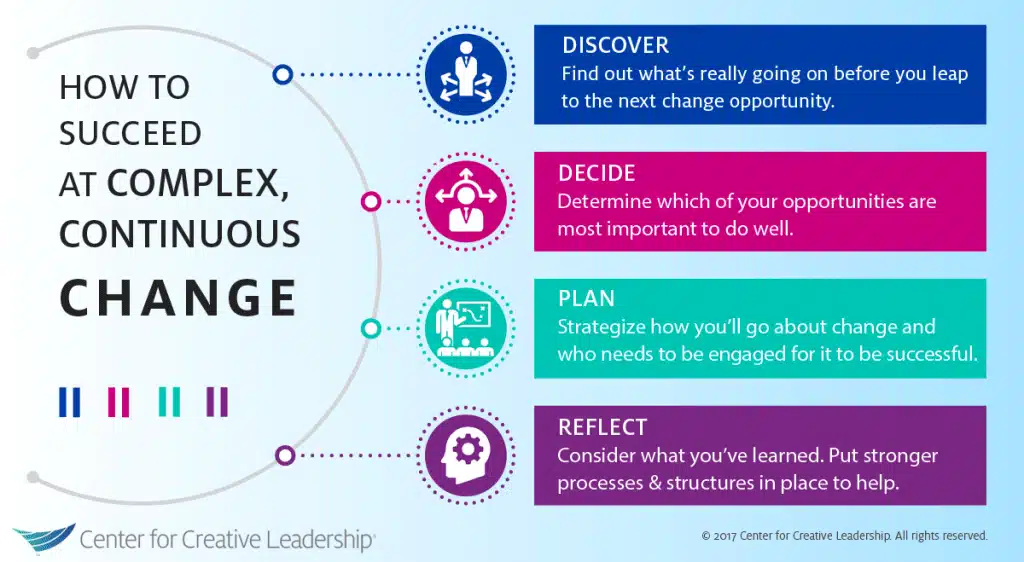All you can eat. Unlimited choices. Endless possibilities.
Abundance is appealing. But, honestly, there is such a thing as too much change, especially at work.
Leaders — it’s time to step away from the buffet.
“Stop heaping more change initiatives and improvement projects on your plate,” says Bill Pasmore, a CCL vice president and organizational leadership expert, who has worked with top executives and board members from numerous Fortune 500 companies.
“You — and your company — can’t take it, and they’re not doing you any good.” After all, change fatigue is real.
Organizations succeed when leaders recognize the need to change and are able to implement changes effectively.
Unfortunately, knowing that change is needed — even picking the right changes — does not guarantee success in making it happen.
Failing at change is all too common. Change efforts fail 50-70% of the time.
This is unacceptable. We need to get better at change — and get better quickly. But how?
As Pasmore explains in the book Leading Continuous Change: Navigating Churn in the Real World, inability to focus and prioritize is one reason strategies falter.
“Leaders know they need to prioritize,” says Pasmore. “But it’s not easy. In a recent CCL survey, 76% of senior leaders said prioritization is very important — but only 10% said they are very effective in doing it. That means 66% of us should be doing something really different.”
Typically, our overwhelming need to respond to threats and opportunities forces us into immediate action, even if not well-conceived.
We try to do too much at once without a coherent plan. We don’t think about how Change A affects Change B and how both changes work against Change C.
We confuse activity with progress, and fail to recognize that all changes, even positive ones, come at a cumulative cost.
Get on Top of Complex, Continuous Change
Instead of all this busyness, we should get on top of things, decide what’s really important, and do those things well.
Change is no longer a single event to map out and go through, in spite of all the popular models that lead us to think that way. In most organizations today, change is complex and continuous, ongoing and simultaneous.
To succeed at complex change, a rigorous approach is needed — probably a more rigorous approach than you are used to.
Most of the advice about leading change and the models we have are based on dealing with a single change effort or change initiative. A single change can’t be teased out or isolated from everything else in the organization, or divorced from other changes taking place at the same time. We are surrounded by churn.
Consider the acquisition of one organization by another. On the surface, it sounds like a single change that must be managed.
In reality, many changes must take place for the acquisition to be integrated successfully. Key decisions about talent in each organization need to be made and the fallout from each decision managed. IT systems and other processes need to be aligned, necessitating changes in technology and retraining for employees. Boards need to be merged, customer relationships transitioned, space reconfigured, brands rationalized, cultures melded, strategies reconciled, and marketing campaigns redesigned.
At the same time, competitors are responding with new moves; new products or services are hitting the market; consumer tastes are evolving; regulations are being imposed; key people are retiring; lean thinking is being implemented; and new strategies are being formulated.
Since change is multifaceted, complex, and continuous, what might seem to be a single change is often anything but — it is a complex change that competes for time, attention, and resources with other changes that are already underway, and those changes yet to be conceived.
As a leader, you know this reality. Every day, you face complex, continuous change, which is defined as a series of overlapping, never-ending, planned, and unplanned changes that are interdependent, difficult to execute, and either can’t — or shouldn’t — be ignored.
You’ll want to adopt specific tools, mindsets, and even structures that enable you to achieve repeatable success when leading complex, continuous changes. There is no simple solution to make these challenges go away — to succeed at complex change, you need to learn and practice some new skills.
How to Succeed at Complex Change
If nothing else, to succeed at complex change, you need to slow down. We recommend you follow this process, as outlined in our white paper:
4 Steps for Success
1. Discover
First, pause to discover what’s really going on before you leap to the next change opportunity and then the next. Do the pre-work that’s necessary to manage changes as a complex, interconnected series of processes.
While change is a necessity, not all change is a necessity right now. The process of discovering allows you to identify viable opportunities for change. Later, having identified those opportunities, decisions can be made about which ones to pursue. The goal is to identify the most important opportunities rather than create an exhaustive list. Discovering requires:
- Stepping back and calling a timeout to do a thorough appraisal of possibilities;
- Scanning, by collecting valid information about the current state of affairs; and
- Visioning, or creating a clear picture of the desired future.
2. Decide
Pause to decide which of many opportunities are most important to do well. Make tough choices among attractive options. Your organization has a limit to how much change it can handle. Until you can build greater change capacity, you must try to avoid overloading the system with change. Trying to do everything is a recipe for failure. Deciding involves:
- Determining what must change in the organization to implement the vision;
- Diagnosing the fit between the current state and the desired state, to better understand what is important to address;
- Focusing and prioritizing in order to step away from the buffet of possible change activities to make certain that the activities we choose will address the most important issues; and
- Scoping and designing the roadmap for the change: who, when, where, and how.
3. Plan, Then Do
Pause to plan how you will go about change and who needs to be engaged for it to be done well and quickly. Sure, push the envelope, but don’t expect your approach to work as planned. Monitor progress, work through organizational and individual lack of readiness, and invest in the creation of greater change capacity.
Then, do. With complex, continuous change:
- Executing is always happening;
- Helping people understand what to pay attention to and why, at any given moment, requires constant communication;
- Engaging people and tapping the collective intelligence of the organization helps the overall change process be faster and more effective; and
- Piloting using rapid prototyping saves enormous time and energy, so that the careful work that leads to successful implementation can take place.
4. Reflect & Discern
Pause to discern what you’ve learned and put in place stronger processes and structures to help you do all of these things better in the future. Take time to see things in perspective, bringing people together frequently to make certain they’re aligned.
In single-change efforts, learning is a low priority because the change may not be repeated. But with complex, continuous change, learning is a wise investment. To learn, we must discern what’s working as intended and what isn’t. Discerning involves:
- Aligning and integrating change efforts in real-time learning;
- Assessing what is being accomplished, compared with what was expected; and
- Adjusting actions going forward, so that more can be accomplished with less.
All along the way, don’t divert your attention until you have either accomplished your objectives or reset your goals to address more urgent needs.
“Stepping away from the buffet” isn’t easy, but it’s certainly doable, Pasmore says.
The more rigorous thinking you do, the more you will be a successful change leader who doesn’t miss half the change equation, and the more you will improve the way that you approach complex, continuous change. And in the end, you’ll be much more satisfied.
Ready to Take the Next Step?
Build your team’s capacity for managing complex change. Our Organizational Leadership experts can partner with you to drive organizational change & transformation.










